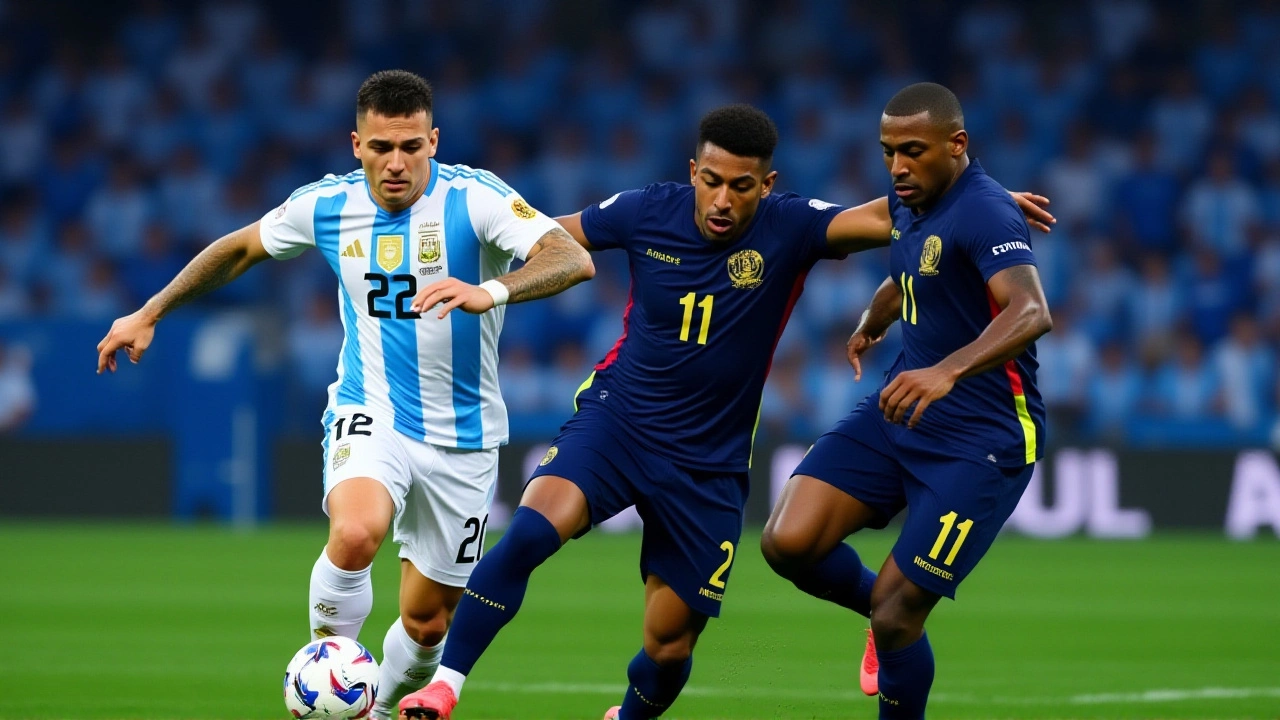When Ecuador national football team steps onto the pitch against the Argentina national football team, the whole of South America feels the tremor. The rivalry dates back to a chilly December night in 1959, and it’s about to flare up again on July 4, 2024, when the two sides meet at the Estadio Monumental Banco Pichincha in Guayaquil as part of the Copa America 2024United States. For fans, the stakes are simple: prove that history can be rewritten, or watch a familiar script unfold.
Historical Overview
Official records show the two nations have clashed anywhere from 18 to 42 times, depending on which database you trust. The oldest encounter listed by 11v11.com was a 1‑1 draw in the 1959 Copa America, played on December 12 in Buenos Aires. A year later, on December 4, 1960, the teams met in a World Cup qualifier and Argentina ran away with a 6‑3 victory. Since then, the tally has tilted heavily in Argentina’s favour, largely because of the three‑time World Cup champions’ deeper talent pool.
Sportsmole’s 2026 World Cup preview notes 42 meetings: Ecuador has 6 wins, 11 draws and 25 losses. SoccerPunter.com, which limits its count to 20 matches, records 4 wins, 6 draws and 10 defeats for Ecuador. The variance is a reminder that not every friendly, youth fixture, or unofficial game makes it into the official FIFA archives.
Statistical Breakdown by Source
Numbers can be confusing, but here’s a quick snapshot:
- Sportsmole: 42 games – Ecuador 6‑11‑25 (W‑D‑L)
- SoccerPunter.com: 20 games – Ecuador 4‑6‑10
- AiScore (since 2004): 18 games – Ecuador 3‑6‑9
- FootyStats.org (last 10 meetings): Ecuador 1‑2‑7
- Livescore.biz (6 games): Ecuador 1‑2‑3
The goal differential across the broader sample sits at roughly 17‑34 in Ecuador’s favour, meaning Argentina scores about 1.7 goals per match while the Ecuadorians manage just under a goal per game. Those figures line up with what former CONMEBOL analyst Diego Córdoba told us: “Argentina’s firepower is obvious, but Ecuador’s defensive discipline has improved dramatically over the last decade.”
Home and Away Dynamics
One of the story’s quirks is Ecuador’s surprisingly solid home record. According to SoccerPunter.com, the Ecuadorians have played nine matches on home soil against Argentina, winning six and drawing three – they’ve never lost at home. The reverse isn’t true: Argentina boasts nine home games with seven wins, one draw and a single loss.
Why does the venue matter so much? The altitude of Quito and the passionate local crowds often tilt the balance. In fact, whenever the Federación Ecuatoriana de Fútbol schedules a match at the Estadio Monumental Banco Pichincha, the pitch conditions favor quick, counter‑attacking play – a style Ecuador has embraced in recent qualifiers.

Recent Form and Tactical Shifts
The last five meetings paint a more nuanced picture. AiScore’s data shows Ecuador winning one, drawing three and losing one, while Argentina’s record stands at two wins, one draw and two losses. Those numbers suggest a narrowing gap, especially when you consider the average goals per game: Ecuador scores 0.6 and concedes just 0.2, whereas Argentina nets 1.6 and lets in 0.4.
Coach José Ramón Sánchez, who took over Ecuador’s senior side in 2022, has emphasized a compact midfield and rapid transitions. He told local outlet El Telégrafo, “We can’t chase Argentina forever; we must make them chase us.” Meanwhile, Argentina’s manager Lionel Scaloni (quoted in a recent press conference) insists his squad will rely on “the classic Argentine flair” but acknowledges “the need to respect Ecuador’s home advantage.”
Upcoming Copa America Clash
Mark your calendars: July 4, 2024, 21:00, Copa America 2024. The venue is still officially listed as “to be confirmed,” but rumors point to the iconic Estadio Monumental Banco Pichincha, given its recent upgrades and the Ecuadorian federation’s push to host a marquee game.
This match sits in the group stage, meaning both teams need a win to guarantee progression. A loss could force a reliance on goal difference, a stat that has haunted Ecuador in past tournaments.
Fans can expect a tactical battle: Ecuador will likely line up in a 4‑2‑3‑1, focusing on a solid back four and a creative midfield trio, while Argentina may deploy their traditional 4‑3‑3, using wingers to stretch the Ecuadorian defense.

What the Numbers Mean for Fans
For the average supporter, the headline—Argentina leads the series—might feel like a foregone conclusion. Yet digging deeper reveals a story of resilience, home‑field advantage, and evolving tactics. If Ecuador can replicate its unbeaten home streak, they could hand Argentina a rare slip‑up that shifts the group dynamics.
Betting markets are already reacting. Asian handicap lines currently favor Argentina at -1.5, but a sharp surge in Ecuador‑backed wagers suggests confidence in a potential upset. As Sports Analyst María Gómez summed up, “The data says Argentina is stronger, but football loves a good surprise, especially in the Copa America.”
Frequently Asked Questions
How does the upcoming match affect Ecuador’s chances of advancing?
A win would virtually guarantee Ecuador a spot in the knockout round, as they would finish top of their group. A draw keeps them in contention but forces them to rely on a favorable goal‑difference, something they’ve struggled with in past Copa America editions.
What historical factors give Ecuador an edge at home?
Ecuador’s unbeaten home record against Argentina (six wins, three draws) stems from playing at altitude, a fervent fan base, and a pitch that rewards quick, direct play. Those conditions have historically unsettled visiting Argentine sides.
Why do different databases report varying head‑to‑head numbers?
The discrepancy arises from the inclusion or exclusion of unofficial friendlies, youth matches, and games not recognized by FIFA. Sportsmole counts every encounter, while SoccerPunter.com limits itself to senior competitive fixtures, leading to the 42‑versus‑20 match count.
Who are the key players to watch for Ecuador?
Midfielder Moisés Caro, who has contributed five assists in the qualifiers, and striker Gonzalo Vasquez, who scored three crucial goals against Bolivia, are likely to be the focal points. Their ability to link play and finish chances will be vital.
What does the statistical trend suggest about future matchups?
While Argentina’s overall dominance remains clear, the narrowing goal‑difference and Ecuador’s solid home form hint at a more balanced rivalry. If Ecuador can maintain its defensive discipline, the next decade could see a series of tighter contests.



